Prevent fiascoes in the food industry
With which 5 aspects can you prevent hassle with the floor?
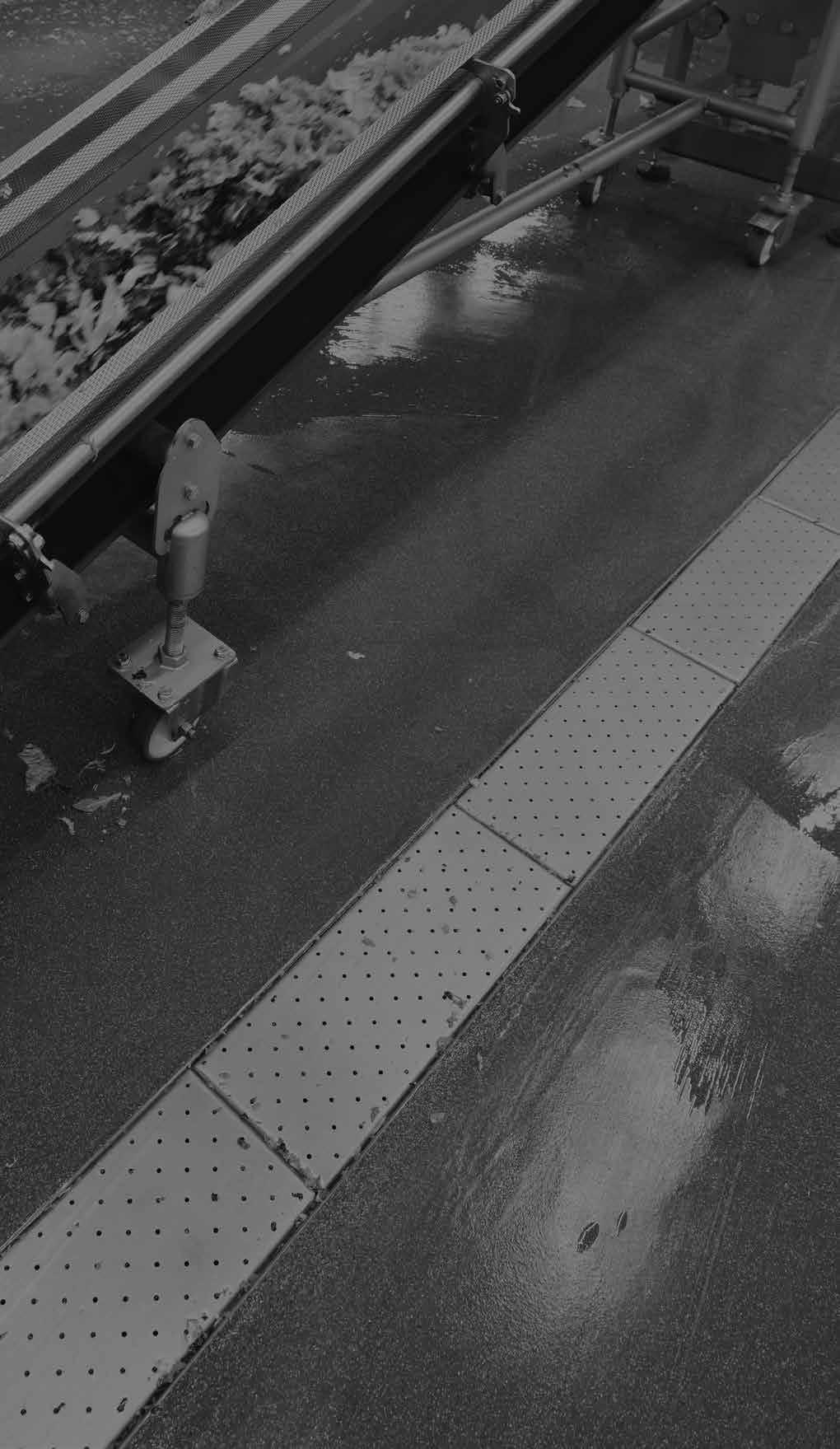
1 The right floor complies with all laws and regulations
2 The right floor keeps the production process running at all times
3 The right floor puts the safety of personnel first
4 The right floor is easy to clean
5 The right floor is suitable for the specific area
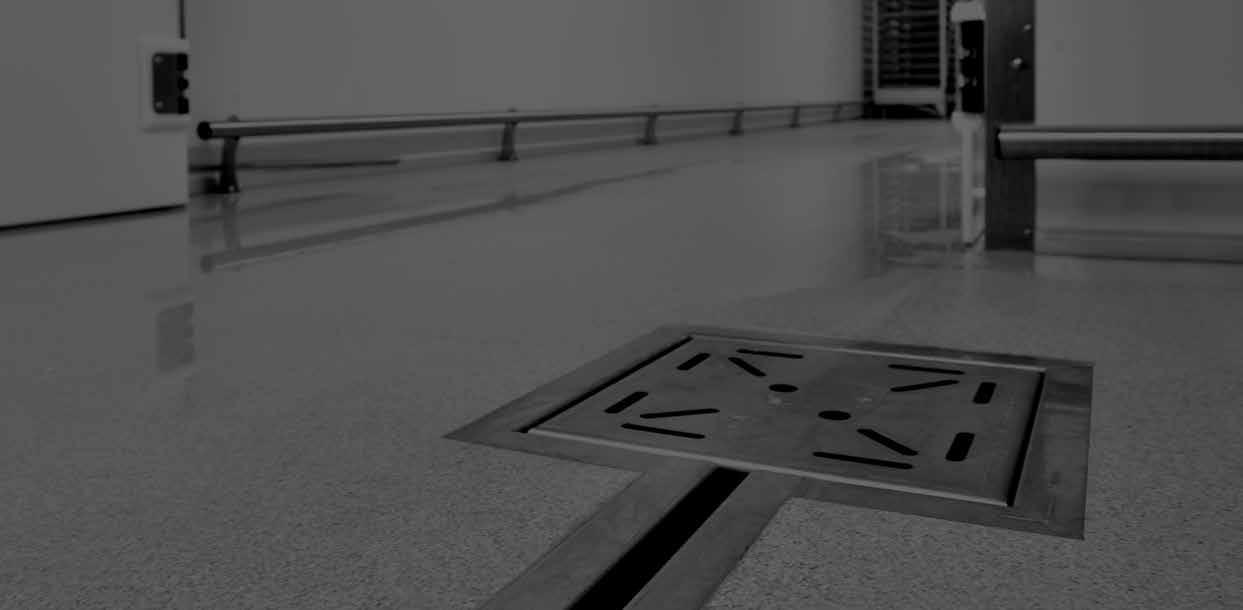
An incorrectly chosen floor can cause a lot of problems in the food industry. Production having to be shut down due to an outbreak of bacteria. Audits that are not passed because of non-compliance with laws and regulations. Cracks in the floor because it turns out not to be resistant to the thermal, chemical or mechanical load of machinery and equipment....
Avoid problems with floors in the food industry and prepare the investment thoroughly. This whitepaper shows what professionals in the food industry should pay attention to when choosing a floor. Which laws and regulations must a floor comply with? How does a floor guarantee a continuous production process? How does a floor ensure safe working conditions? What do you need to consider when it comes to cleaning a floor? Which floor is suitable for which area? The right preparation can make the difference between a fiasco and a floor suitable for at least 20 years of intensive use.
The 5 aspects that flooring in the food industry must meet
This whitepaper discusses the 5 aspects a floor in the food industry must comply with. An overview:
1 The right floor complies with all laws and regulations
2 The right floor keeps the production process running at all times
3 The right floor puts staff safety first
4 The right floor is easy to clean
5 The right floor is suitable for the specific areae
Upfront: what could go wrong?
Hygiene is key in the food industry. And hygiene in the food industry literally starts with the basics: the floor. A wrongly chosen floor can therefore cause a lot of misery. A floor that is insufficiently wear-resistant or not resistant to mechanical, chemical, thermal or electrical loads can get damaged. The acids, bases and alkalis used in the food industry will quickly damage an incorrectly chosen
floor. Machinery and heavy traffic from means of transport will cause cracks and fissures. Dirt, dust and micro-organisms accumulate, with major risks to food safety. The same applies to a floor that is not completely seamless, pore-tight and therefore impenetrable. Here, bacteria and fungi can multiply in joints or seams. The transition from floors to walls and drains, for example, should be seamless for the same reason. Also, if a floor is difficult to clean or not resistant to chemical cleaners, bacteria and fungi can have free rein. Finally, repairing an incorrect or got damaged floor means stopping production. Unwanted production losses and high costs are the result.
To prevent all this misery, a floor in the food industry must comply with 5 aspects. They are discussed in detail below.
1 The right floor complies with all laws and regulations
The food industry has to deal with different types of certifications, the best known of which are HACCP, BRC Food Safety, IFS Food and FSSC 22000. HACCP is designed to identify, assess and control risks during the production process. For industrial floors in the food industry, this often involves risks such as contamination, wear and tear or inadequate cleaning. In general, according to HACCP, a floor should be easy to clean and easy to disinfect. This is why HACCP floors are often laid seamlessly and finished with liquid-tight seams. If the floor is impermeable to liquids, they cannot adhere and also not affect the substrate or foundation of the premises. According to HACCP, the floor must not be slippery. Fall risks must be reduced by a good anti-slip coating. HACCP also requires that the floor must not get damaged. An HACCP-
certified floor must therefore be sturdy and wear-resistant.
IFS Food and BRC Food Safety are also designed to ensure food safety. Among other things, a floor that meets these guidelines is easy to clean and disinfect and prevents contamination. Furthermore, an IFS Food and BRC Food Safety certified floor is impermeable and wear-resistant. In addition, hygienic drainage of water and other liquids is guaranteed. In food processing areas, water and other liquids are easily directed to the drain and puddles of water and other liquids are avoided.
According to FSSC 22000 certification, a floor must, among other things, be hygienic and easy to clean to minimise the risk of contamination. A floor that meets FSSC 22000 standards is resistant to chemical cleaning agents or disinfectants. In addition, in food processing areas, joints between walls and floors are rounded to facilitate cleaning. In wet process areas, the floor is liquid-tight. Furthermore, the floor is designed to avoid standing water. An FSSC 22000 certified floor meets requirements in terms of anti-slip properties.

CLICK HERE
A flooring system that still does not give a fuss after 20 years and passes all audits effortlessly? See how the floor remains sustainable at Schmidt Zeevis.
‘A failed HACCP audit can shut down a company for a long period’
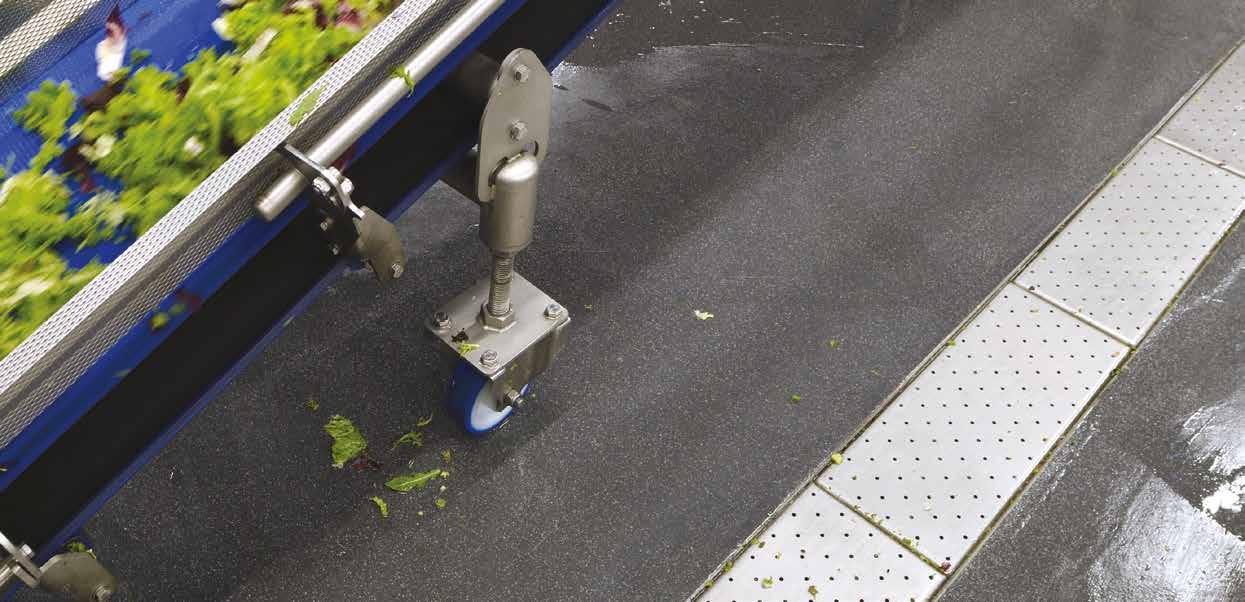
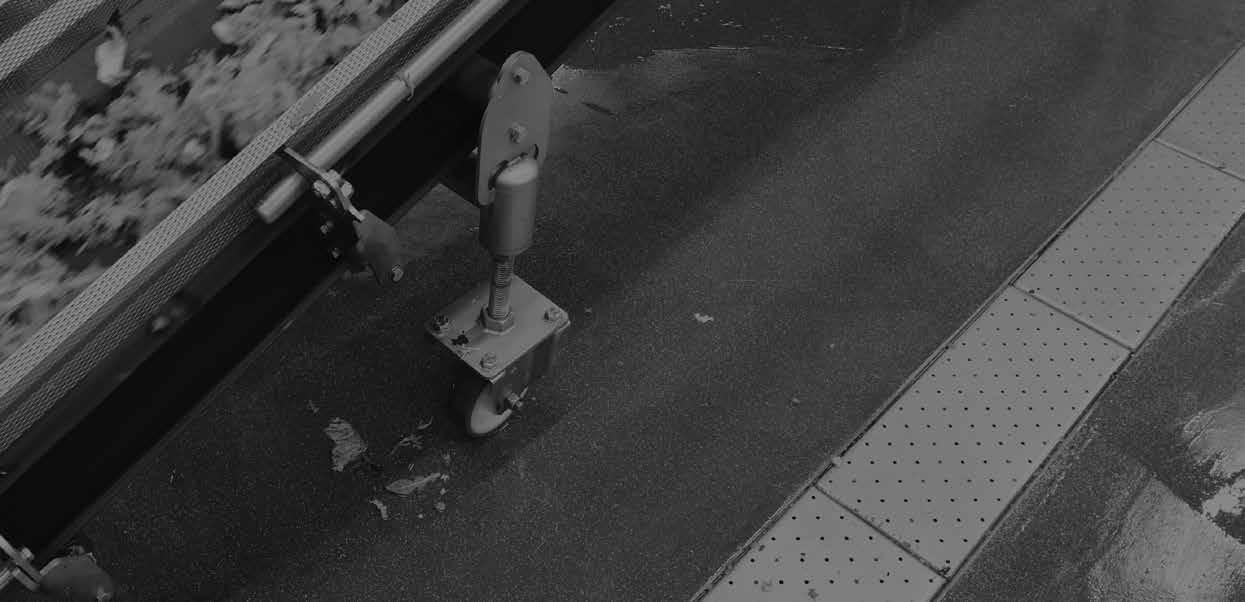
2
The right floor keeps the production process running at all times
In the food industry, all kinds of risks lurk that threaten food safety. In bakeries, there is a microbiological climate in which mould, among other things, can thrive, especially if moist ingredients are used. In the fish processing industry, raw, fresh products are handled and there is a risk of contamination from various bacteria, especially when cleaning, cutting and filleting fish. The dairy industry must also take appropriate measures to ensure that bacteria such as salmonella and listeria do not stand a chance.
Outbreaks of viruses, bacteria, yeasts or moulds can have huge consequences for companies in the food industry. The same applies if foreign objects unintentionally enter products or chemical contamination occurs during production, processing, transport or storage. If a product does not comply with
food safety requirements, this can be grounds for a warning, fine or even a recall of the product in question. If a food safety hazard is found during an inspection by the Dutch Food and Consumer Product Safety Authority, in the worst case, production has to be stopped, resulting in huge sales losses. A failed HACCP audit can also shut down the company for a long period. Food safety incidents can also cause major reputational damage.
The right floor contributes to good hygiene and to keeping the production process running. In a seamless, pore-tight floor, viruses, bacteria, yeasts or moulds have no chance of settling in. An abrasion-resistant floor prevents cracks and damage and thus dirt accumulation. A floor that is easy to clean and resistant to chemicals can eliminate any risk of infection.
Do we have an example of a floor where bacteria are nested? What does this look like, how do the bacteria pose a danger.

3
The right floor puts staff safety first
Every year, around 200,000 workers in the Netherlands are victims of a workplace accident. Slipping on a slippery floor is in the top 10 most common workplace accidents. Falls can occur because the floor is contaminated with oil, chemicals or fine dust, but also because the floor surface turns out to be too slippery due to insufficient slip resistance and too low a coefficient of friction. Sometimes cleaning the floor with detergents creates unsafe situations and sometimes leakage during the production process is the culprit. Either way, an incorrectly chosen floor can cause slips and falls. These not only cause personal suffering, but can also have nasty legal consequences for food companies.
Laws and regulations focus on the personal safety of employees, setting specific requirements for the floor. According to the Working Conditions Decree, it must be free of unevenness and dangerous slopes and, as far as possible, be solid, stable and antiskid. Good slip resistance is therefore important.
Non-slip properties according to DIN
Water and chemicals, but also ingredients or animal residues can make a floor in the food industry very slippery. A non-slip, antiskid top layer completely eliminates the risks of slips and falls.
Ensuring employee safety is therefore an important consideration when choosing the right floor. In doing so, it is a good idea to consider how much anti-slip is needed. Does the company have a wet or dry production process? Does it handle a lot of water or other liquids? Are there greasy products or dust? How often is floor cleaned and how?
To ensure that employees can work safely and do not slip or even fall, a floor must be made sufficiently antiskid. But not too antiskid either, because then bacteria can settle in the floor and it will not be easy to clean. A floor must also remain antiskid, even if it is cleaned daily with water and chemicals. A flooring manufacturer can do all kinds of tests to check whether a new floor has the desired level of skid resistance. Regular testing of existing floors is important to determine whether they are still sufficiently antiskid.
To prevent slipping, companies in the food industry must take preventive measures. This means that the floor must provide satisfactory grip under all conditions. German industry standards are used to determine the anti-slip properties of floors. DIN 51130 applies to general work areas and DIN 51097 to areas with high humidity.
In DIN 51130, the slip class is determined by the slope angle at which a person can still move safely on a floor. The standard uses R-values to indicate the anti-slip class. In total, there are five different R-values (9 to 13). Class R9 covers floors with the lowest slip resistance requirements. The highest requirements apply to floors classified in class R13. To illustrate: R13 represents very high grip at a slope of more than 35°.
In DIN 51097, slip values A, B or C apply. These added values represent slip risks in different areas. The higher the class, the more slip resistance is required of the floors.
4
The right floor is easy to clean
Ease of cleaning is an important consideration when choosing the right floor. In the food industry, it must be possible to clean the floor thoroughly every day if necessary. Bacteria, fungi, yeasts and viruses must not be given a breeding ground to survive in any way. This means first and foremost that the floor must be non-porous. A floor system must therefore be completely sealed over its entire thickness. This is in contrast to floors where often only the sealing top layer is responsible for sealing the floor. If that sealing gets damaged, seepage can occur and, for example, mould can grow in the floor. A fully sealed floor excludes this problem.
In addition, the floor must be able to withstand daily use of high-pressure sprayers and chemicals. In addition, the floor must be quick to clean. After all, cleaning costs time and money, and in the food industry daily cleaning is often a must, especially in the case of wet production and processing. The shorter the cleaning time, the lower the costs.
Cleaning an industrial floor is a necessity and specialist work. It is too advisable to have a
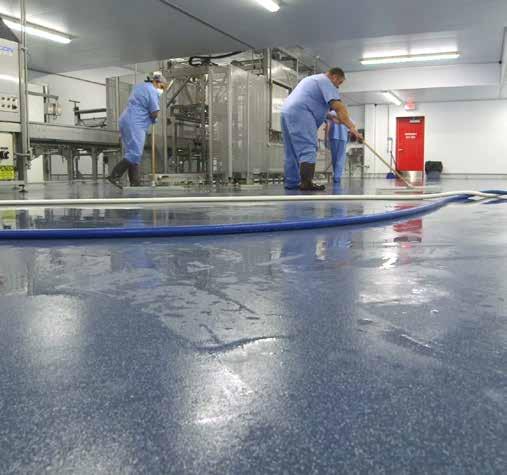
A floor system that is very easy to clean, resistant to the use of pressure washers and cleaning chemicals is recommended in areas where daily cleaning is a must. See how floors are cleaned at hatchery Bell & Evens.
specialist draw up a cleaning protocol. The right way of cleaning maintains the functional properties of a floor and thus ensures hygiene. It also makes sense to have the floors checked periodically to ensure safety and hygiene.
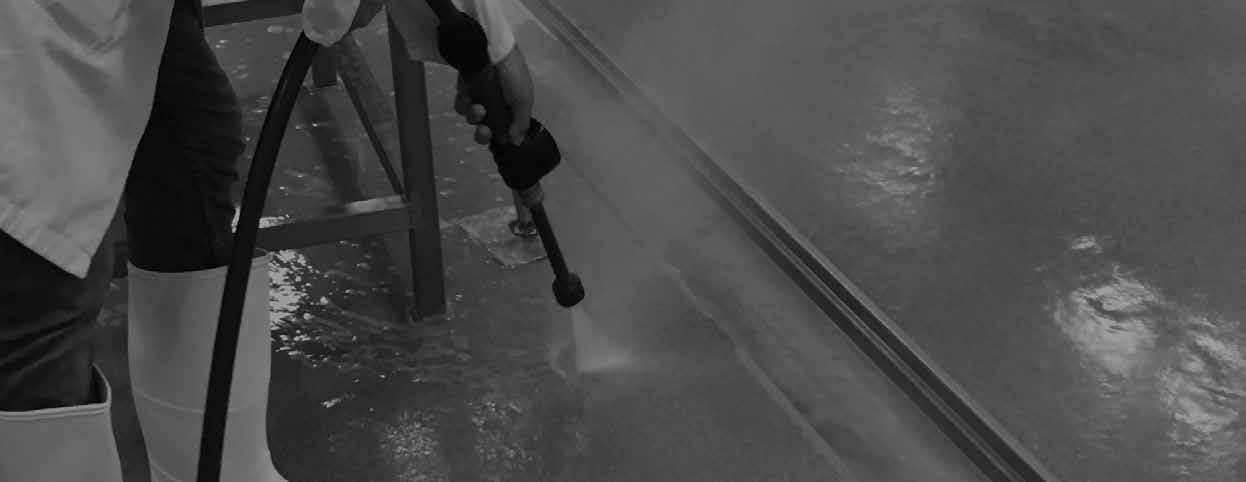
‘Reinigingsgemak is een belangrijke afweging bij het kiezen van de juiste vloer.
CLICK HERE
5
The right floor for the specific area
Flooring has specific functions at each stage of the food industry’s production and processing process. At arrival on site, during cleaning, cutting, heating, processing, freezing, packaging and when preparing for transport. The floor finish must be specifically tailored to each function and area. Besides being seamless, antiskid, easy to clean, the floor
must have optimum mechanical and, where necessary, chemical, thermal and electrical resistance. Different areas and their specific requirements for floor systems are discussed below.
Common areas and what the stressors are in each. Name chemicals that play a role, name mechanical impacts with numbers. How much pressure does a floor have to withstand? What does that mean for the floor you will choose?
System comparison Bolidtop® 700, Bolidtop® 700 RF, Bolidtop® 801, PU Cement, Hexagonal tiles.
Production areas
A typical production process of a food company: products and raw materials arrive daily and are immediately washed and cut before undergoing dry process steps and finally being frozen. Three stages that place completely different demands on the floor when it comes to slope, thermal load and chemical load. This shows
SYSTEM COMPARISON Properties Notes Bolidtop 700 Bolidtop 700 RF Bolidtop 801 PU Cement Hexagonal tiles Basics epoxy epoxy polyurethane polyurethane & cement ceramic System layers 4 layers 4 layers 1 layer minimal 2 layers minimal 2 layers Substrates new + existing concrete new + existing concrete new + existing concrete new + existing concrete new + existing concrete Destructive pre-treatment not required not required not required required not required Installation in-house specialists in-house specialists in-house specialists third parties third parties Start of installation ** after stabilizing of the substrate & max. residual moisture percentage of 2.5% after stabilizing of the substrate & max. residual moisture percentage of 2.5% after stabilizing subsoil & wind-dry surface on 7 days old concrete after stabilization of substrate Lead time of installation *** 4 days 4 days 1 day 2 days 1 day Seamless seamless seamless seamless seamless with seams Surface texture light surface texture rough surface texture medium surface texture medium surface texture variable Layer thickness 5 mm 5 mm 5 mm 6 mm 18 mm Skid resistance DIN51130 R10 R12 R11 R11 R9 - R12 Water absorption no no no no 0,05% Density 2.218 kg/m3 2.218 kg/m3 2.132 kg/m3 2.090 kg/m3 not proven Tensile strength - EN 13892-2 25 MPa 25 MPa 18 MPa 14 MPa not proven Tensile strength - BS6319 deel 7 6 MPa 6 MPa 8 MPa 6 MPa 6 MPa Impact and shock resistance good good very good good good Scratch resistance good good good good good Chemical resistance **** good good very good very good good Thermal resistance -25 °C tot +80 °C, incidentally +100°C -25 °C tot +80 °C, incidentally +100 °C -25 °C tot +100 °C, incidentally +190 °C en -196 °C -25 °C tot +80 °C not proven Posssible to walk on 24 hours 24 hours 48 hours 24 hours 24 hours Full curing of system 7 days 7 days 7 days 7 days 2 days Emission low emission, no food deterioration low emission, no food deterioration extreme low emission, no food deterioration extreme low emission, no food deterioration not proven Fire resistance Bfl-S1 Bfl-S1 Bfl-S1 Bfl-S1 Bfl-S1 Colour possibilities 21 colours 21 colours 9 colours 6 colours 6 colours HACCP certification yes yes yes yes yes Halal certification yes yes yes yes yes Awarding Breeam points yes yes yes yes yes Notes The installation of flooring systems is done by in-house specialists, once the processing of those systems is done by the same company that developed and produced the systems. ** The residual moisture percentage of concrete floors and sand cement screeds may not exceed 2.5% when using a vapor-tight synthetic floor finish, which is measured at a depth of 2 cm using the calcium carbide method. This is generally achieved in new concrete and sand cement substrates after an aging period of at least 28 days. This percentage can be achieved earlier at higher temperatures, e.g. by installing electric heaters and dehumidifiers in the room. Compared to the other flooring systems, the Bolidtop 801 system can be installed faster on wind-dried substrates. *** An example of a 100 m2 room was used in the comparison. The days listed do not include any substrate preparation and the full curing time of the flooring system. **** A summary of chemical resistance tests performed with (an)organic acids, solvents, bases and alkalis can be received upon request.
SYSTEM COMPARISON CLICK TO ENLARGE
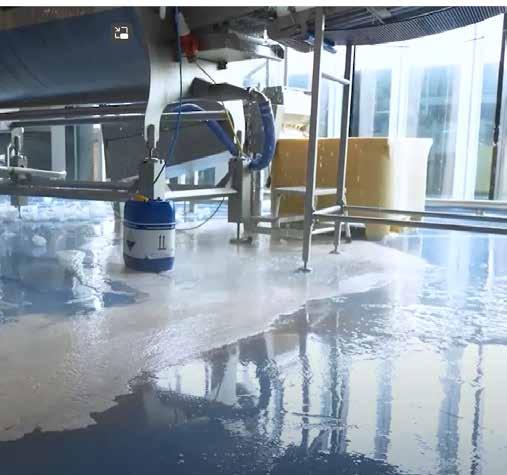
here also need to be easy to clean. A daily process that can be very time-consuming if the wrong floor is chosen.
Cooling and freezing areas
Companies in the food industry often have refrigerated storage or production areas. In some cases, products are also frozen. These conditions call for temperatureresistant floors. A dust-binding sealing of the concrete subfloor is highly effective and facilitates cleaning. Even in cold storage and freezer rooms, the floor must withstand intensive forklift traffic and also meet HACCP requirements. This is achieved by a liquidtight floor finished with hollow plinths, ball sills and/or rounded corners. Where the floor meets walls and gutters, these seamless transitions ensure that no dirt can accumulate.
Loading and unloading areas
just how versatile a floor has to be in the food industry. In general, production areas place very high demands on the mechanical and chemical resistance of floor systems. In the food industry, floors must not only meet HACCP requirements and thus be seamless, impermeable and durable, but also resist chemicals such as acids, bases, alkalis and detergents, intensive driving traffic, falling objects and abrasive influences. In addition, the floor must be safe in both dry and wet conditions. So a perfect anti-slip function is also crucial. In addition, the right floor is easy to clean daily.
Packaging areas
In packaging areas, the floor has to withstand foot traffic and the use of transport equipment, such as forklift trucks and pallet trolleys. As with production areas, the floors
Loading and unloading bays have a lot to endure. Trucks are loaded and unloaded using forklift trucks and hand pallet trucks. This causes intensive loading and abrasive wear on the floor surface. As some loading and unloading takes place outdoors, the floors must also provide sufficient grip in wet conditions. A durable and antiskid wear layer makes this possible.
Laboratories
In food companies that have their own laboratories, it is important that the floor here does not emit particles or retain particles from the air or environment. A seamless, smooth and pore-tight floor is therefore a requirement. Furthermore, the floor often has to be resistant to aggressive chemicals, such as organic and inorganic acids and solvents. Laboratories should also be free of dust. Electrically conductive floors counteract static charges and thus contribute to good functionality. Naturally, hygiene is also
CLICK HERE
The fish processing industry has many wet production areas. The floors in these areas are heavily loaded and that too in wet conditions. Visscher Seafood in Urk shows which considerations they made when choosing the floor.
important in laboratories and the floor should be easy to clean here too.
Other areas
Specific requirements also apply to floors in other areas. For example, floors in offices must be durable and scratch-resistant and have a calm, pleasant appearance. For corridors, food companies often have additional requirements for flatness, seamlessness and barrier-free transitions with adjacent areas. For the entrance, the building’s calling card, colour, shape and material of the floor are decisive. In addition, high wear resistance and good cleanability are necessary. In toilets, changing rooms and showers, hygiene is obviously of major importance. Straight or sharp corners where dirt can remain should be avoided as much as possible.

Flooring systems should not only ensure optimum safety and durability, but also look good. Well-coordinated flooring advice contributes to a comfortable and modern working environment. See how Panarex bakeries matched their flooring choices to the specific functions in their production process.
The solution: the 1-layer floor system
Much is demanded of the floor in the food industry. Hygiene, personal safety and mechanical, chemical and thermal and electrical loads play an important role. The floor must also be comfortable, representative and beautiful.
Bolidt has floor systems specifically tailored to the different areas within a food company. In addition, Bolidt has developed a new material that minimises the shutdown time resulting from the realisation of the floor. The solution to this is a 1-layer floor system that can be installed very quickly after pouring the supporting floor.
The new 1-layer floor system meets all the required conditions, making it applicable in any specific area in any segment of the food industry. The new flooring systems have comparable mechanical properties to the proven Bolidtop® 700 system. Compared to epoxy-based and competing systems, the new flooring systems have exceptionally high pressure resistance at high temperatures. The floor continues to perform well even under heavy loads.
The lead time for applying the new system is minimal. As a result, the production process can be restarted faster. The floor can be used again after only 24 hours. Because the new floor system consists of only 1 layer, the cost of the floor is lower. In addition, the single-layer floor system can be installed with little shrinkage. As a result, less preparatory work is required and no structural adjustments to the supporting structure and substructure have to be made.
CLICK HERE
Want to know more?
For a sound flooring advice and more information:
Bolidt
P.O. box 131
3340 AC Hendrik-Ido-Ambacht
T +31 (0)78 684 54 44 export@bolidt.com food.bolidt.com/en
About Bolidt
Bolidt has been inventing innovations with thermosetting synthetics for 60 years. The synthetic systems are used worldwide in industrial floors, ship decks, wearing courses in road and utility construction and sports floors. In the food industry, Bolidt has been active for more than 50 years. The synthetic floors are completely pore-sealed and therefore hygienic: bacteria, fungi, yeasts and viruses have no chance to settle in the floor. Bolidt floors are applied seamlessly and are also resistant to mechanical, chemical, thermal and electrical loads. Meanwhile, Bolidt floor systems are applied in the bakery industry, dairy industry, AGF industry, seafood industry and the poultry industry.
Apart from the material, the working method is uniquely different. Bolidt keeps everything in its own hands: from developing, producing, selling to applying the floors. Work preparation, purchasing and logistics are also carried out by Bolidt itself. Every part of the value stream can thus be optimally geared to the food industry. This too enables Bolidt to provide the best quality in terms of safety and hygiene.










